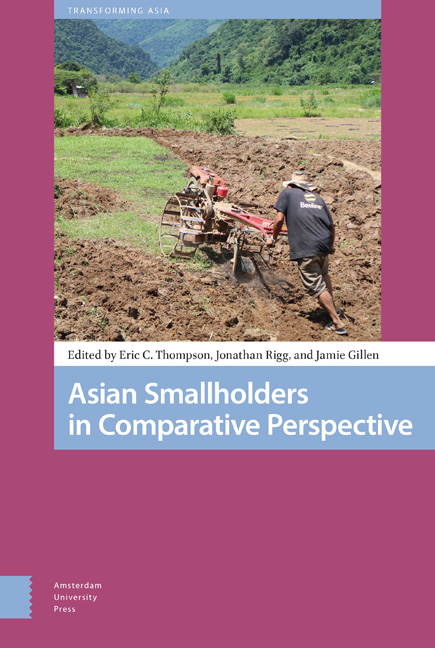Book contents
- Frontmatter
- Contents
- List of Maps, Figures and Tables
- Preface
- Introduction: Asian Smallholders in Comparative Perspective
- 1 Cambodia: Political Strife and Problematic Land Tenure
- 2 Indonesia: Whither Involution, Demographics, and Development?
- 3 Japan: Government Interventions and Part-time Family Farming
- 4 Laos: Responding to Pressures and Opportunities
- 5 Malaysia: The State of/in Village Agriculture
- 6 The Philippines: Fragmented Agriculture , Aquaculture, and Vulnerable Livelihoods
- 7 Singapore: Making Space for Farming
- 8 Taiwan: Toward the Revitalization of Smallholder Agriculture
- 9 Thailand: The Political Economy of Post-Peasant Agriculture
- 10 Vietnam: From Socialist Transformation to Reform
- Index
6 - The Philippines: Fragmented Agriculture , Aquaculture, and Vulnerable Livelihoods
Published online by Cambridge University Press: 21 November 2020
- Frontmatter
- Contents
- List of Maps, Figures and Tables
- Preface
- Introduction: Asian Smallholders in Comparative Perspective
- 1 Cambodia: Political Strife and Problematic Land Tenure
- 2 Indonesia: Whither Involution, Demographics, and Development?
- 3 Japan: Government Interventions and Part-time Family Farming
- 4 Laos: Responding to Pressures and Opportunities
- 5 Malaysia: The State of/in Village Agriculture
- 6 The Philippines: Fragmented Agriculture , Aquaculture, and Vulnerable Livelihoods
- 7 Singapore: Making Space for Farming
- 8 Taiwan: Toward the Revitalization of Smallholder Agriculture
- 9 Thailand: The Political Economy of Post-Peasant Agriculture
- 10 Vietnam: From Socialist Transformation to Reform
- Index
Summary
Abstract
This chapter analyses the state of smallholders in the Philippines and discusses the reasons for the relative underperformance of Philippine agriculture and fisheries as well as the inability to translate economic growth and agricultural export successes into rural poverty reduction. The available evidence does not indicate any significant trends towards commercialized and middle-class smallholders. The overall picture suggests continuing fragmentation and continuing rural population growth. It also remains to be seen whether aquaculture can act as a solution to deal with overfishing in an inclusive manner. A shift towards a fairer political system would benefit rural poverty reduction. Nevertheless, generating a sufficient level of political will remains a daunting task given the continuing influence of large landowning families.
Keywords: aquaculture, fisheries, indigenous people, land reform, the Philippines, rural politics, rural poverty
In the immediate post-World War II period, observers forecast a bright future for the Philippines. In several ways, the Philippines was indeed better positioned than neighbouring Southeast Asian countries. The country was spared massive Cold War devastations and enjoyed agricultural successes in the 1960s and 1970s. The Green Revolution in rice was initiated at the International Rice Research Institute in Los Banos, Laguna in the mid-1960s with the introduction of genetically engineered high-yielding varieties, most notably the IR8 variety. The Philippines became an international knowledge centre for the agricultural sciences. Rice production surged and the country managed to achieve self-sufficiency in the late 1970s (Ulack 2000: p. 422). In addition, the plantation economy thrived. The export value of raw sugarcane, the traditional colonial plantation crop, increased from USD 137 million in 1965 to its peak level of USD 624 million in 1980 (Doner 2009: p. 143). As Balisacan and Hill (2003: p.1) noted: “By the mid-1960s there was still little evidence that things were to go seriously wrong. Indeed, the country was largely free of the major problems then besetting Southeast Asia”.
In the 1980s however, economic development in various sectors, including those of agriculture and fisheries, started to lose vibrancy. Meanwhile, other Southeast Asian countries in the 1990s, such as Thailand, Indonesia, and especially Vietnam were enjoying a period of impressive agricultural performance, livelihood improvements for smallholders, and overall rural poverty reduction.
- Type
- Chapter
- Information
- Asian Smallholders in Comparative Perspective , pp. 181 - 212Publisher: Amsterdam University PressPrint publication year: 2019



